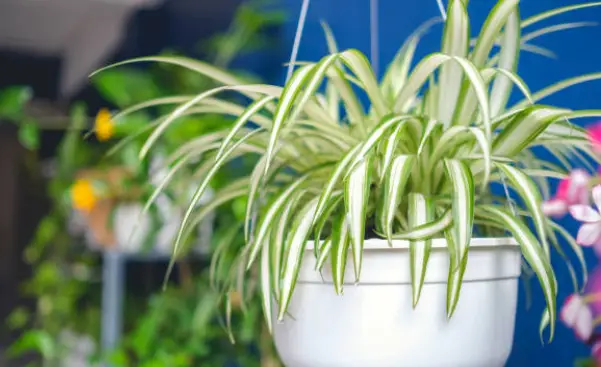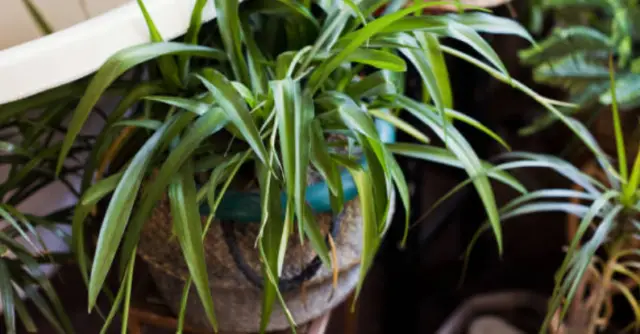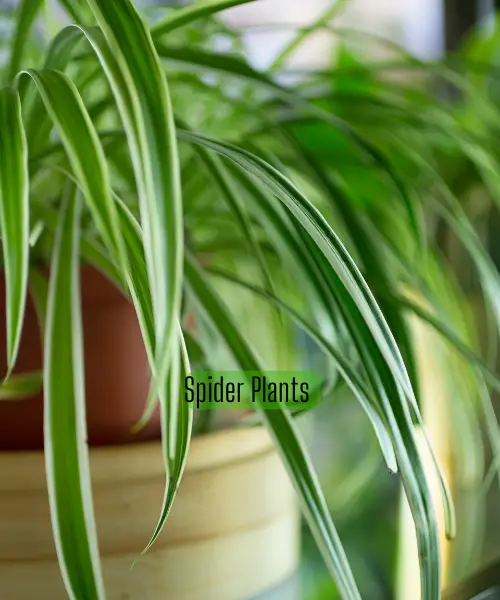Spider plants (Chlorophytum comosum) are one of the most popular houseplants around. With their quirky spiked leaves and trails of delicate plantlets dangling from their arching stems, spider plants add a fun, unique touch to any indoor space.
But there’s one question that often comes up about these beloved plants: Are spider plants poisonous? The short answer is no; spider plants are not poisonous to humans or pets when ingested in small amounts. However, that doesn’t mean they are completely risk-free. Let’s take a closer look at the potential toxicity of spider plants.
What Makes a Plant Poisonous?

Are Spider Plants Poisonous
Before we dive into spider plants specifically, it’s helpful to understand what makes a plant poisonous in the first place. Many plants produce toxic compounds called alkaloids as a defense mechanism against being eaten by herbivores, insects, and other creatures.
Some well-known poisonous houseplants like lilies, oleander, and philodendron, contain alkaloids that can cause symptoms like vomiting, diarrhea, excessive drooling, lethargy, and even liver damage or death if ingested in large quantities. Even seemingly innocuous plants like English ivy, calla lilies, and peace lilies contain compounds that could cause stomach upset and irritation in curious kids or pets.
Are spider plants toxic?
So where do spider plants fall on the toxicity scale? According to the ASPCA, spider plants are considered non-toxic to cats, dogs, and horses. The leaves and plantlets contain no alkaloids or other poisonous compounds that would typically cause serious symptoms in people or pets.

However, spider plants do contain a fairly benign compound called hydrogen cyanide. Before you panic, this is the same compound found in foods like apple seeds, lima beans, and cassava root. Tiny amounts of well-processed hydrogen cyanide are actually considered harmless for humans and animals to ingest.
Potential Side Effects of Ingesting Spider Plants
Even though spider plants aren’t poisonous per se, ingesting large quantities could potentially cause some mild gastrointestinal issues, like:
- Vomiting
- Diarrhea
- Nausea
- Abdominal discomfort
The fibrous leaves and stems of spider plants are simply not meant to be consumed. So if a curious child, cat, or dog ingests a significant amount of the plant, they could experience some temporary stomach upset.
That said, many veterinarians and children’s hospitals report no issues at all from spider plant ingestion. And even sites dedicated to identifying toxic houseplants rank spider plants as effectively non-toxic when consumed in moderate amounts.
So in most cases, nibbling or inadvertent ingestion of a spider plant is typically nothing to worry about for kids or pets. The potential side effects would likely be very mild gastrointestinal discomfort at most. But to be safe, it’s still wise to discourage overconsumption.
Tips for Keeping Spider Plants Away from Kids & Pets
Since spider plants aren’t completely risk-free, especially with their tempting, dangly plantlets, it’s smart to take some precautions to restrict access:

Are Spider Plants poisonous?
- Place spider plants out of reach of young kids and pets who may be inclined to nibble on them.
- Use hanging baskets or place plants up high on shelves or plant stands.
- Spray the leaves periodically with pet-safe deterrent sprays to discourage nibbling.
- Close off rooms with spider plants when kids or pets can’t be supervised.
- Consider keeping spider plants out of households with very young children or pets until they can be trained not to eat plants.
With a few common-sense precautions, the very low risk of spider plant ingestion can easily be mitigated.
Spider Plant Benefits & Care Tips

So, now that we’ve covered the potential risks and non-toxicity of spider plants, let’s talk about what makes these plants so popular and easy to care for.
Spider plants are beloved for many reasons, including:
- Hardy and difficult to kill, tolerating a wide range of conditions
- Non-toxic and pet- and kid-friendly compared to many other houseplants
- Easily available and inexpensive to purchase
- Produce offshoots you can root and share with friends as gifts
- Highly efficient at filtering indoor air and absorbing airborne toxins
- Add sculptural shape, varying texture and visual interest
To keep your spider plant thriving, follow these basic care tips:
- Bright, indirect sunlight is best; avoid direct, intense sun
- Water moderately, allowing the soil to dry between waterings
- Use a fast-draining potting mix to prevent soggy soil
- Apply a balanced liquid fertilizer every few weeks during spring and summer
- Remove offshoots with root systems and repot in their own containers
- Avoid cold drafts; aim for average household temperatures
- Wipe leaves periodically with a damp cloth to remove dust buildup
With their easygoing nature and unique looks, it’s no wonder spider plants are a staple in so many homes! Just take common-sense precautions and they make a fun, vibrant, and basically non-toxic addition.
Other Popular Non-Toxic Houseplants
If you’re looking for other houseplants that are safe for kids and pets, here are some other great non-toxic options to consider:
Boston Fern
Just like spider plants, Boston ferns are given a safe, non-toxic rating by both the ASPCA and NASA. Their lush, cascading fronds add gorgeous texture to any room.
Phalaenopsis Orchids
The common moth orchid variety is non-toxic and easy to care for. Orchids provide stunning, long-lasting blooms in a huge array of colors.
Bunny Ear Cactus
These adorable, fuzzy cacti have soft, squishy pads rather than sharp spikes. They’re an offbeat and 100% pet-safe succulent option.
Peperomia
There are loads of peperomia varieties to choose from, like ripple pepperonia and watermelon peperomia. They’re all non-poisonous and super low-maintenance.
Hoya
The wax-like clusters of hoya flowers are non-toxic and long-lasting. Plus, caring for these trailing vines is about as easy as it gets!
Air Plants
Since air plants don’t need soil at all, they’re perfect for households with kids or pets who may dig in potting mix. Just mist the plants occasionally.
When you stick to spider plants and other non-toxic houseplant varieties, you can decorate with greenery to your heart’s content without worrying about any toxic hazards for your family or fur babies.
The Takeaway on Spider Plant Safety
To summarize, while spider plants technically contain trace amounts of generally harmless compounds like hydrogen cyanide, they are considered effectively non-toxic. Nibbling on part of the plant may cause very temporary, minor stomach upset at most.
Even the ASPCA, which watches carefully for potential plant toxicity risks to animals, gives spider plants their full safety seal of approval. As long as ingestion is limited, these trendy plants pose minimal risk to curious kids or pets.
Of course, it’s still smart to supervise children and animals around any houseplants and take precautions to limit ingestion. But overall, spider plants rate among the best and safest indoor plant choices for homes with little ones and furry friends roaming around.
So feel free to embrace the quirky, easygoing charm of spider plants without fear! They add amazing texture and visual interest while staying non-toxic. If you stick to common plant care and location, these fun, trailing greens make an awesome addition to your indoor plant collection.




